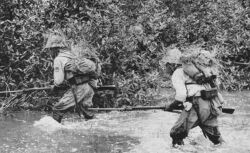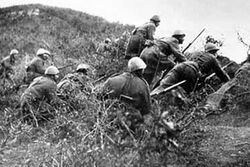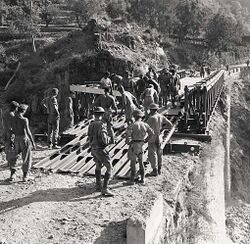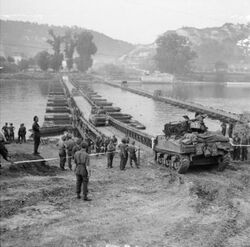Manas River Offensive
| Manas River Offensive | |||||||
|---|---|---|---|---|---|---|---|
| Part of the Nepali-Bhutania Campaign of the Second Europan War | |||||||
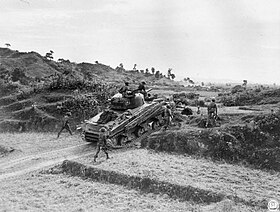 ERUAC forces engaging with Quenminese positions near the Manas River | |||||||
| |||||||
| Belligerents | |||||||
| Commanders and leaders | |||||||
| Strength | |||||||
|
155,000 troops 400 tanks 200 aircraft 75 guns |
175,000 troops 350 tanks 300 aircraft 50 guns | ||||||
| Casualties and losses | |||||||
| Moderate to Heavy | Very Heavy | ||||||
The Manas River Offensive (1 August - 18 August 1943) was the climax of the Nepali-Bhutania Campaign in which Quenminese Marshal Mạc Hiếu Quang attempted to retake the initiative by attempting a dagger-thrust towards Bethausian forces across the Manas River. Quang seized the opportunity while Sugiyama remained in Bhutania trying to secure the region, in which he believed that with the Allies forces split, it would enable him to somehow force the Allied forces in Nepali back and regain some lost territories.
The offensive would prove to be the climax of the campaign; as commanders of both sides were both in crucial positions which determined the fate of the campaign. Historians believed that had ERUAC Forces failed to relieve the Bethausians, the consequence for the allies would be catastrophic.
Background and Prelude
Following the Himalaeyan Offensive, and the Battles at Thimphu and Trongsa, Lucian Field Marshal Sugiyama's quest to liberating Bhutania was almost complete as pockets of Imperial forces in the region remained. The Himalaeyan Offensive committed during the previous May caused the beginning of the Imperials to lose their foothold in the Nepali-Bhutania Region. Revolts continued to grow and Marshal Quang continued to be dissuaded as the news of more uprisings took place throughout the region. Whilst Quang did realise that Sugiyama had used the advantage of the local's hostility towards the Imperial forces to his own advantage, Quang was not able to completely obtain the loyalty of the locals. The reason rooted from Quenminese Marshal Count Thạch Hung Sõn Chiến's persecution of the locals, which caused both Nepalians and Bhutanians to look at Imperial forces with hostility.
On the previous month, while the the Battles in the Nepalian towns of Mongar and Jakar saw minimal successes for the Imperials, the prevailing conditions of the revolts caused both the Quenminese and Archadians to lose their focus on taking on the Allied forces, which looked as if the Imperials were fighting the enemy on multiple fronts. Armoured warfare was left much to be desired, as there was little room to manoeuvre in the mountainous terrain of Nepali and Bhutania, which prevented Quenminese General Phó Minh Duyên from using his army's mobile capabilities.
The SOE committed a small forces to support the Long-Range Asianna Force, which was the reconnaissance and raiding unit composed of troops from the UK, Erebonia, Rubrum, Zanarkand, and New Akiba. The primary task of the LRAF was to carry out deep penetration, covert reconnaissance patrols and intelligence missions behind Imperial lines. However, the units were often tasked with destroying and distrupting Imperial supply lines, which hampered the ability of Imperial forces to reinforce and provide support to ground forces. Codenamed Operation Bite, the LRAF and SOE were combined to carry out these attacks and prevent the Imperials from regaining the upper hand and prevent losses during the closing days of the Middle East Campaign.
The Battle
1 August - 5 August: Quang and Sazabio assault Bethausian lines
On the night of the 1st of August, Quang and Sazabio's forces crossed the Manas River and threw a massive artillery strike, which surprised the Bethausian forces situated at 2 kms away from the Manas River. When dawn had come, Imperial forces crossed the river and committed a combined head-on assault. General Duyen's mobile armour force attacked the weakest part of the Bethausian lines to the north in an attempt to encircle General Maung's 2nd Bethausian Division and besiege it near the small town of Yahala. A part of General Quang's forces attacked Maung's southern flank, which would see the Bethausians in the north totally cut off. Arkar knew that if his northern flank were to be encircled, the battle would be lost.
He immediately sent General Yaza's forces to fight through Duyen's encirclement and help the besieged division to withdraw. On 4 August, Yaza's 6th Bethausian Armoured Division, along with the Aasialainer regiment, The Duke Consort's Guards Regiment engaged with the Quenminese forces southwest of Yahala. The two Bethausian formations were successful in relieving the town and rescuing the trapped division, allowing Maung to retreat his forces back.
Meanwhile, Sazabio's forces engaged with General Sein Khine's forces in the south. Here, the Bethausians were more successful, owning to the terrain advantage that their defensive positions possessed. Filiberto committed the 9th Folgore Division in an attempt to cut off the Bethausians but however, Arkar managed to reinforce Khine's forces and Sazabio was forced to renew his attack on 5 August, which by that time, Maung and Yaza had successfully withdrawn to the defensive lines just 20 kms from Jakar.
By this time, the news of the surprise offensive had reached Sugiyama. He immediately ordered Lindholm's Estharian and Balambian Expeditionary Force to pull out of the Himalaeyan region and to reinforce the Bethausians near Jakar, as he was kept preoccupied with the remaining Imperial pockets in Bhutania.
6 August - 10 August: Arkar establishes a defensive line just 20 kms from Jakar
As early as 4 August, Arkar had begun to establish a defensive line just 20 kms from Jakar. Without Sugiyama to support him, he knew it would only be matter of time before his line would fall and the Imperials would be free to retake and recapture Jakar. By 6 August, the Bethausians had successfully prepared in the short span of time that they had. The Bethausians had support in the form of the RAF, which the Bethausians would use to send in air strikes against attacking Imperial columns and formations.
On 7 August, Marshal Quang ordered the first attempt to force the Bethausians back, but were however, beaten back. On the evening of the same day, Quenminese artillery pounded on Bethausian positions between the north and southern flank. Quang's plan of attack called for Sazabio's forces in the south, and Duyen's forces in the north to pincer the entire defending Bethausian forces, as retribution for the losses during the Battle of the Khost Gap. A capture of the entire Bethausian force would be disasterous and humiliating for the Allies. Realising this, Arkar ordered General Khine to commit raids on Archadian lines in the south, to delay their attacks while the central and northern flanks would remain to fend off Imperial thrusts.
From 7 to 10 August, Quang had thrown numerous thrusts but in so far, the Bethausian lines remained steady and solid.
10 August - 12 August: Lindholm reinforces Arkar's forces near Jakar; Bethausian and Estharian forces hold
On 9 August, Lindholm's forces had successfully secured the Himalaeyan passes. As soon as it was declared secure, Lindholm immediately swung his forces south to Jakar to aid the defending Bethausian forces. On 10 August, the first Estharian forces arrived on Arkar's defensive line, which served as a relief for the latter. Lindholm's forces reinforced Maung's flank by the time that Duyen threw another armoured attack. The Estharians succeeded in reinforcing the defensive lines. The Balambians were tasked to harass Quenminese lines in an attempt to prevent Quang's northern flank from committing another attack. With this, Quang and Sazabio committed 2 nights of continuous artillery attacks in an attempt to soften the defenses and enable the push.
On 12 August, Quang sent in a massive attack, which called for Duyen's armoured force to shift flanks and aid the attack on the central flank. General Quang's forces committed an attack on both the central and northern flank, while Duyen navigated the weakest part between the two Bethausian flanks and pincer the center. Duyen's thrust surprised both Lindholm and Arkar, as Duyen successfully isolated the Bethausian flanks by pushing towards the Estharian lines, which prevented Lindholm from reinforcing Arkar's forces. By the evening, tensions ran high in the Allied planning room at Jakar. The battle was slowly being won by the Imperials with both Arkar and Lindholm being unable to sleep during that night.
At 2am on 13 August, Arkar radioed Sugiyama that Lindholm's and his army were unable to counter the Imperials any further and that the lines were dangerously close to being overrun. The only force what was seen as capable of relieving them were the ERUAC forces near the Nepali-Bhutania border in the north under General Regnitz and Testarossa respectively. Days before, Regnitz and Testarossa were preparing to cross the border and into Bhutania, but Sugiyama immediately ordered them to swing and turn around to relieve the Bethausians near Jakar. The two generals immediately prepared their forces, which took from 5 to 12 August. The delays were bought about the mountainous nature of the border area. Despite it, the Erebonians and Rubrumians managed to swing south and attempt to relieve the Estharians and Bethausians.
6 August - August 13: Regnitz and Testarossa swing the ERUAC forces south to relieve the Arkar and Lindholm; Imperial forces attempt to halt ERUAC forces at Runikhata
Following Regnitz and Testarossa's isolation of Marshal Trương Ngọc Thái Bình's forces, they moved closer to the Indiae-Bhutania border on the border town of Zhemgang. in hopes of joining Sugiyama's forces. But at 5:00pm in 6 August 1943, the two received a transmission from Sugiyama ordering them to immediately swing south to attempt to reinforce the Bethausians at Jakar. Many of his fellow officers were skeptical of moving the entire army group because of the mountainous terrain and numerous zig-zag roads. When Regnitz asked for an estimate of their arrival to Jakar, he was told that it would take nearly 14 days to move the entire army group south. Regnitz rebutted and told his generals that he would make it less than 6 days. Despite the skepticism of his subordinates, Regnitz nonetheless accepted the task of reinforcing Arkar. By the following day, Regnitz and Testarossa would set off. The ERUAC forces would have difficulty of traversing the mountainous roads and bends that two-way roads turned into one way traffic.
A Luftwaffe reconnaissance plane immediately reported to Marshal Quang about the Allied movement heading to the south. Immediately, he ordered East Europan forces consisting of both Reichmacht and the Waffen-SS to go to Runikhata to attempt to bottle down Regnitz. In August 9, after 3 days of non-stop movement, the ERUAC forces had finally arrived on the lowlands and proceeded to march to Runikhata, the last town before Jakar. But instead, they were greeted by elements of East Europan forces along with elements of crack SS divisions. Regnitz encountered heavy resistance and engaged Imperial forces for the next 2 days at Runikhata. General Alfred Toht Kiesling and his 12th SS Panzer Division attempted to conduct a pincer against Regnitz but the latter pressed the elements of the 6th Erebonian Armoured Division and an ensuing tank clash took place on the western flank of the town. Although the SS offered tough resistance, Erebonian forces had managed to blunt the attempt, allowing the 2nd Rubrumian Division to split from the main force and encircle Reichmacht units on the eastern flank of the town, thereby surrounding at least 12,000 troops. Regnitz pushed the bulk of his army into Runikhata that by the night of 12 August, the East Europan forces were forced off Runikhata, leaving 5,000 encircled troops to be captured by ERUAC forces and continued his march to Jakar. By the morning of the 13 of August, Regnitz and Testarossa were now only 10kms from the frontline at Jakar, and 7kms from the Imperial forces. At 12nn, Regnitz and Testarossa agreed to split their forces; Regnitz's Erebonian Corps would attempt to relieve the Bethausians in the northern flank, while Testarossa's Rubrumian Corps would engage with the Quenminese rear guard, limiting their ability to send reinforcements and force Quang to fight on his front and rear.
On the afternoon of the same day, Erebonian forces engaged with the rear flank of the Quenminese in the northern flank, prompting Duyen to dispatch a few of his armoured columns to engage with the Erebonians. By this time, the Imperials were nearing on the shortage of fuel, as the loss of the Middle Eastern Oil Fields severely hampered their operations. With this, Elements of the 9th Erebonian Armoured Division engaged with Duyen's more mobile force while the famed 6th Erebonian Armoured Division would use the opportunity to thrust towards General Maung's flank.
Despite the harsh terrain, Regnitz committed a number of armour against Duyen's force. Regnitz planned to blow Duyen's armoured force out of fuel in an attempt to prevent Duyen from shifting his forces to reinforce and prevent the 6th Erebonian Division's relief force. This attack would also render any combat vehicle and tanks useless. Between the afternoon of the 13 and 14, Duyen faced the full brunt of Regnitz armoured attack. Quang attempted to support Duyen but Arkar dispatched the 1st Bethausian Division to prevent them from eliminating Regnitz's force.
14 August: Elements of the 6th Erebonian Armoured Division links up with the battered remnants of Maung's 2nd Bethausian Division; Testarossa's Rubrumian forces engages with the rear of both Sazabio and Quang's forces
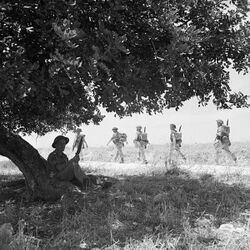
On 14 August, the climax of the battle would take place, with numerous tank-on-tank engagements taking place between Regnitz's 9th Armoured and Duyen's 81st Mobile Armoured. This would be the battle throughout the campaign in which tanks were used to their full capacity. Regnitz had the advantage in numbers and supplies while Duyen had the advantage in terrain. But with the scarcity of fuel beginning to affect Imperial forces, they slowly started to lose the advantage. During the battle, Erebonian tank crews reported several Imperial tank crews abandoning their tank despite it still being in top shape, which meant that the tank was out of fuel. Certain Imperial tanks needed fuel to advance closer to make their guns work while the guns on the Commonwealth tanks had the range and accuracy to engage them as far as 1000 metres. Regnitz had the advantage as his tanks could easily pick off advancing armoured columns.
With the incidents of fuel scarcity, Duyen was left with no choice but to call off the encirclement and retreat with the remaining serviceable vehicles and armour. Quang immediately ordered the retreat of the Imperial forces on the central and northern flanks following Regnitz success over Duyen.
At 6pm, the Nortia Rifle Regiment of the 6th Erebonian Armoured Division successfully linked-up with remnants of the 2nd Bethausian Division near Dipathar.
15 August - 17 August: Regnitz, Arkar, and Lindholm strike a counteroffensive to force Imperial forces to retreat and to prevent the fall of Testarossa's force
While Regnitz had successfully relieved the Bethausians and Estharians, Testarossa was still engaging with the Quenminese rear guard. At this time, Marshal Quang had already ordered a retreat. Marshal Quang ordered Generals Duyen and Quang to engage with the Rubrumians and if possible, attempt to destroy it. Testarossa's forces remained resilient on their ground. However, Testarossa knew that his force would be unable to hold on for much long. As a result, Regnitz ordered the 9th Erebonian Armoured Division to chase Duyen's retreating column. By this time, Lindholm's Estharian forces were finally free to send in support. Lindholm dispatched the 5th Balambian Hussars to aid the Erebonians to relieving Testarossa. Arkar committed General Khine's forces to chase Sazabio in the south. General Yaza's 4th Bethausian Division was immediately dispatched to aid Testarossa.
On the afternoon of 16 August, the combined Allied forces engaged with the delaying Imperial force. The Bethausians managed to thrust to the east of Testarossa's flank, effectively surrounding the Quenminese and Archadian forces trying to buy the retreating force time. On the following morning, Testarossa pushed his forces forward on the trapped rear guard, enabling General Arkar to push the bulk of his army to chase the Imperials to the Manas River. By the evening of 17 August, General Arkar's forces reached the Manas River and began constructing Pontoon bridges after the Imperials had destroyed the bridges on the Manas River.
18 August: Combined Allied Forces cross the Manas River and force the Imperials to retreat
In the morning of 18 August, Marshal Quang realised that the offensive had failed to reach its intended objective. While inflicting casualties on the Allies, particularly the Bethausians, his plan to give the Imperial forces in the campaign a breathing room failed. With what remained of his force, he ordered them to retreat to Trashigang and prepare defences and call for reinforcements from Indiae. At this time, Imperial forces had suffered nearly 2/3rds of casualties of their initial strength, with many falling into capture by the Allies.
At 12 noon, the Bethausians finished the pontoon bridges and the allies crossed the Manas River on the road to Trashigang. By this time, only a handful of Imperial troops remained to fight but were eventually pulled out once the main army had already committed a retreat. Lindholm and Arkar continued to pursue Quang as far as the outskirts of Trashigang by 20 August.
Aftermath
The Manas River Offensive proved to be the final major offensive in the Nepali-Bhutania Campaign. It was considered by many to be Marshal Mạc Hiếu Quang's greatest loss ever since taking over command from Marshal Count Thạch Hung Sõn Chiến. The Manas River Offensve could have been a major Imperial success had the Imperials prevented the fall of the oil reserves near Mongar. The conclusion of the battle decided the fate of the campaign, as Marshal Sugiyama would later recross the border and encircle Marshal Quang's forces at Trashigang.
The Allies frequently had numerical superiority. With the advent of new weapons and armamants, the Allies had the edge over their Imperial counterparts. Throughout the campaign, Allied artillery was handled superbly and Allied air support was excellent in contrast to the Quenminese and Archadian air power, which offered mediocre ground support, preferring air-to-air combat instead. The battle was decided with who had the best supporting assets, Sugiyama wrote.
The Allies suffered minor to middle casualties with 29,798 dead or wounded. In contrast to the Imperials, who suffered 59,789 dead or wounded. The Allies lost a meagre number of armoured force while the Imperials suffered greatly, owing to the fact that fuel start to go scarce during the build-up to the climax of the battle. The Allies lost 49 planes while the Imperials lost 87 planes.
Subsequently, Field Marshal Archibald Sugiyama launched Mission Kenton which was the plan to encircle Trashigang and end the Imperial rule in both Bhutania and Nepali. In 30 August, Imperial forces were evacuated from the region to the safety of Quenminese-occupied Indiae. While most of the Imperial General's Staff escaped, Quenminese Marshal Quang was forced to surrender after Sugiyama threw a surprise attack on 2 September that finally ended Imperial rule in the region. The following day, Allied forces crossed the border into Indiae for the first time. At the same time, Marshal Count Thạch Hung Sõn Chiến regained his command.
